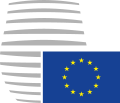|
Presidency of the Council of the European Union
The presidency of the Council of the European Union[1] is responsible for the functioning of the Council of the European Union, which is the co-legislator of the EU legislature alongside the European Parliament. It rotates among the member states of the EU every six months. The presidency is not an individual, but rather the position is held by a national government. It is sometimes incorrectly referred to as the "president of the European Union". The presidency's function is to chair meetings of the council, determine its agendas, set a work program and facilitate dialogue both at Council meetings and with other EU institutions. The presidency is currently, as of January 2025, held by Poland. Three successive presidencies are known as presidency trios. The current trio is made up of Poland (January–June 2025), Denmark (July–December 2025), and Cyprus (January–June 2026).[2] The 2020 German presidency began the second cycle of presidencies, after the system was introduced in 2007.[3] HistoryWhen the council was established, its work was minimal and the presidency rotated between each of the then six members every six months. However, as the work load of the Council grew and the membership increased, the lack of coordination between each successive six-month presidency hindered the development of long-term priorities for the EU. In order to rectify the lack of coordination, the idea of trio presidencies was put forward where groups of three successive presidencies cooperated on a common political program. This was implemented in 2007 and formally laid down in the EU treaties in 2009 by the Treaty of Lisbon. Until 2009, the Presidency had assumed political responsibility in all areas of European integration and it played a vital role in brokering high-level political decisions. The Treaty of Lisbon reduced the importance of the Presidency significantly by officially separating the European Council from the Council of the European Union. Simultaneously it split the foreign affairs Council configuration from the General Affairs configuration and created the position of High Representative of the Union for Foreign Affairs and Security Policy. After the United Kingdom's vote to leave the European Union in 2016 and its subsequent relinquishment of its scheduled presidency in the Council of the European Union which was due to take place from July to December 2017, the rotation of presidencies was brought six months forward. Estonia was scheduled to take over the UK's six-month slot instead.[4] The presidency is currently (as of January 2025) held by Poland.[5] Functioning
The Council meets in various formations where its composition depends on the topic discussed. For example, the Agriculture Council is composed of the national ministers responsible for Agriculture.[6] The primary responsibility of the Presidency is to organise and chair all meetings of the council, apart from the Foreign Affairs Council which is chaired by the High Representative. So, for instance, the Minister of Agriculture for the state holding the presidency chairs the Agriculture council. This role includes working out compromises capable of resolving difficulties. Article 16(9) of the Treaty on European Union provides:
Each three successive presidencies cooperate on a "triple-shared presidency" work together over an 18-month period to accomplish a common agenda by the current president simply continuing the work of the previous "lead-president" after the end of his/her term. This ensures more consistency in comparison to a usual single six-month presidency and each three includes a new member state. This allows new member states to hold the presidency sooner and helps old member states pass their experience to the new members. The role of the rotating Council Presidency includes:
Holding the rotating Council Presidency includes both advantages and disadvantages for member states; The opportunities include:
The burdens include:
List of rotations
See also
Notes
References
External links
|
||||||||||||||||||||||||||||||||||||||||||||||||||||||||||||||||||||||||||||||||||||||||||||||||||||||||||||||||||||||||||||||||||||||||||||||||||||||||||||||||||||||||||||||||||||||||||||||||||||||||||||||||||||||||||||||||||||||||||||||||||||||||||||||||||||||||||||||||||||||||||||||||||||||||||||||||||||||||||||||||||||||||||||||||||||||||||||||||||||||||||||||||||||||||||||||||||||||||||||||||||||||||||||||||||||||||||||||||||||||||||||||||||||||||||||||||||||||||||||||||||||||||||||||||||||||||||||||||||||||||||||||||||||||||||||||||||||||||||||||||||||||||||||||||||||||||||







